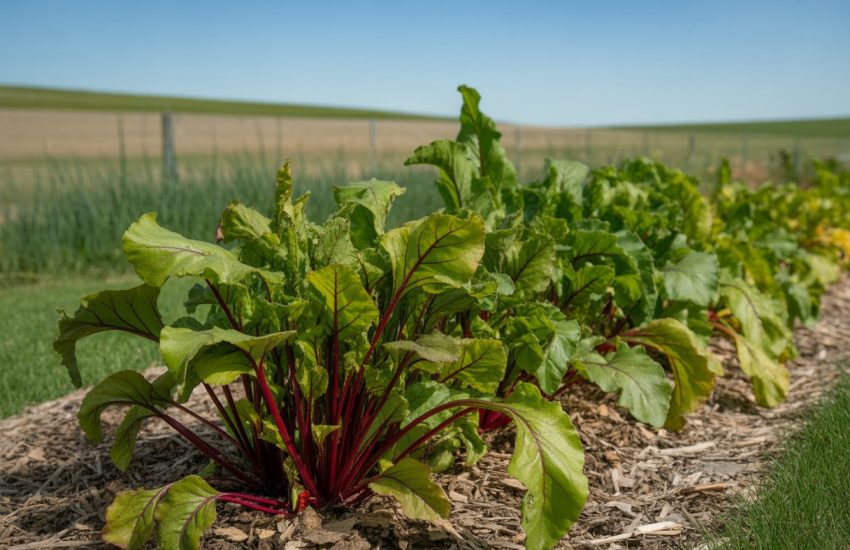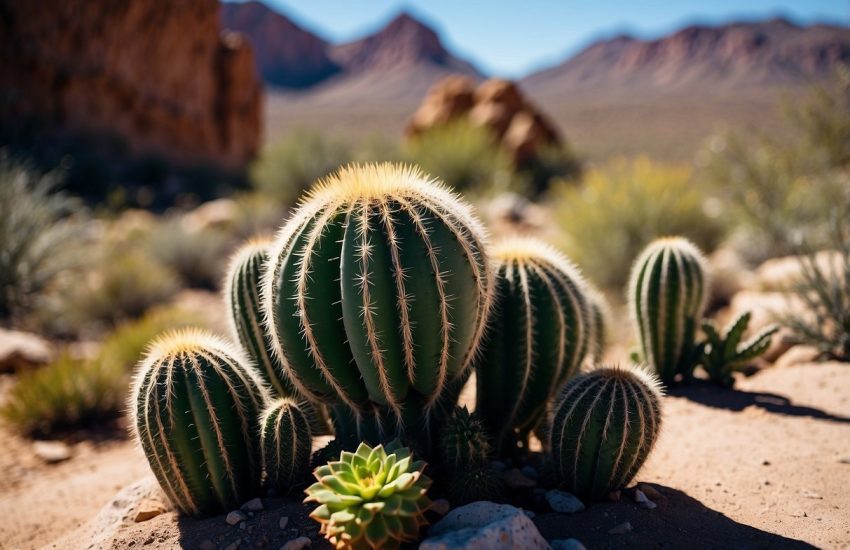Michigan Native Plants for Landscaping [with Pictures]
Michigan’s rich botanical heritage is an excellent resource for native plants suitable for growing in the state. This article offers a list of native plants found in and around Michigan suitable for every gardener to grow. Some can be used as ornamentals, while others have medicinal properties. You’ll find everything from ornamental grasses to wildflowers, shrubs, vines, and trees when browsing this list of plants available to grow in your backyard or flower garden.
Michigan Native Trees for Landscaping
American Basswood
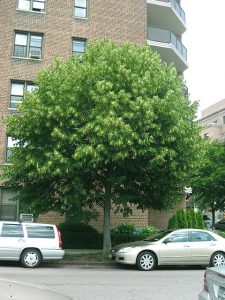
The basswood tree is a tall, graceful shade tree with heart-shaped, green leaves that turn a soft yellow in the fall. Its large, white flowers bloom from May to June and are followed by flat seed pods that resemble birches. Basswoods are moderate-growing trees, reaching an average height of 60 feet. They can live for 50 to 100 years and develop wide-spreading root systems, making them great for erosion control once they’re established. They thrive in moist soil but are tolerant of dry soil as well. If planted in open areas, it’s best to plant two or more trees so that one can act as a windbreak for the other. Basswoods also work well in large groups, making excellent privacy trees. Basswoods are fast-growing trees and should be kept pruned to maintain a dense green canopy that can help shade flowers and assist with soil moisture retention. The best time to plant basswoods is when the tree is young or still in the seedling stage before it gets too tall.
Black Cherry
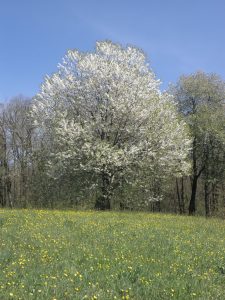
The Black Cherry tree is an evergreen shrub or small tree that grows to a height of 20 feet tall and 12 feet wide, with dark green glossy leaves turning bright red in fall. The small, white flowers bloom in April, followed by a red or black cherries. They are perfect for wet, moist soil areas, a stream bank, or lakefront property. They also make great trees for wildlife habitats. Black Cherry trees are fast growing and do best in full sun but can tolerate part shade. They need well-drained soil but will grow on less than ideal soil if they’re in a sunny location. They’re susceptible to several diseases and pests such as leaf spots and borers and deer and rabbit damage. You’ll want to provide protective cover until they become established in the landscape. Black Cherries can be used as a hedge or an ornamental tree.
American Elm

The American Elm is a large shade tree that grows to 80 feet tall with a trunk diameter of 20 inches for young trees and up to 30 inches for older trees. The foliage is dark green in summer and turns burgundy-red in fall. The small, oval leaves have shallow teeth along the edges and are shiny dark green on top and silver-green underneath. They’re traditionally grown in moist, well-drained soil but also tolerate wetter conditions where they’re planted along streams, lakeshores, or near wetlands. They do well in sun or shade, but the light shade is best to keep the leaves from getting scorched in full sun. They’re not recommended for areas with hot, dry conditions such as roadsides and should be planted where they have plenty of space for their shallow root system.
Redbud
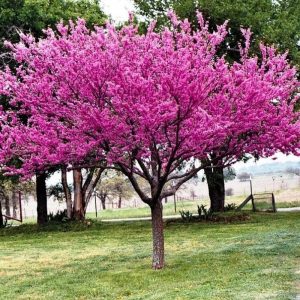
Redbud trees are small or large shrubs that grow to 25 feet or less and bloom in early spring before the leaves emerge on the tree, making them very ornamental. The small flowers are pinkish-white and hang downward on short stalks. The small red to purple-pink seed pods are heavily spotted and remain through the winter on the tree. Redbud trees will grow in poor soil conditions but prefer a moist, well-drained location. They should be planted in full sun for best flowering and growth and can tolerate part shade.
Willow
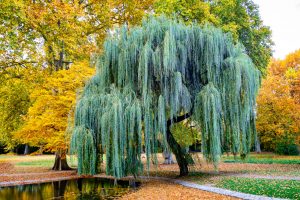
Thirteen species of native willow trees have been identified in Michigan, most of which are shrubs with thin trunks, although some can grow as large as small trees. They’re ideal for stream banks and wetlands where they provide food and shelter for wildlife. They are shallow rooted, so if planted against a slope, you may need to provide additional support for the roots. Willow trees tolerate wet and dry soil conditions and can be planted in full or partial sun. They are evergreen when young but lose their leaves as they age. Willow shrubs are medium-sized shrubs with long branches that can reach heights of 10 feet or more.
Silver Maple
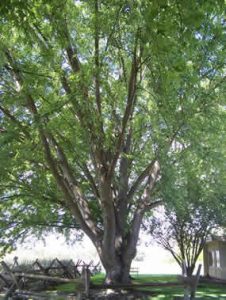
The Silver Maple is a large shade tree that can attain heights of 60 to 90 feet tall with a trunk diameter of 12 inches. The silver bark peels back in strips to expose the deeply furrowed gray bark underneath, making it an attractive tree for wildlife habitat. The leaves are large and heart-shaped with a pointed tip and palmately divided, with five to seven lobes. They turn yellow and orange in the fall. The small flowers bloom in early spring on long stalks that produce clusters of red seeds called samaras which are shed in the fall. The Silver Maple tree is easy to recognize when growing along rivers, streams, or lakeshores because the lower roots extend out over the water source, while the upper part of the tree grows in average soil above. Silver Maples can be planted as lawn trees but should be kept well-trimmed because they tend to become top-heavy as they mature. They also work well as shade trees or in large groupings.
Sugar Maple
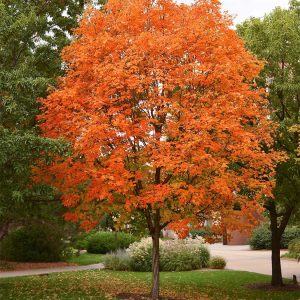
The Sugar Maple is a fast-growing shade tree that will grow to heights of 70 to 100 feet tall with a trunk diameter of 2o inches for young trees and up to four feet in diameter for older trees. The silver-gray bark has vertical ridges that are heavily furrowed back and forth, making it an attractive tree for wildlife habitat. The leaves are large and heart-shaped with a pointed tip and palmately divided, with five to seven lobes.
Spicebush
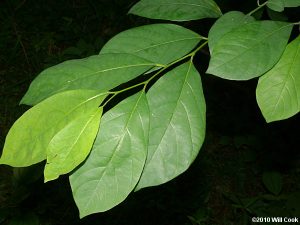
Spicebush is a small deciduous tree with fragrant purple blossoms that bloom in mid-spring. The berries are yellowish-green, produce a spicy flavor when dried, and are harvested commercially to flavor foods like jellies, sauces, or baked goods.
Chokecherry Tree
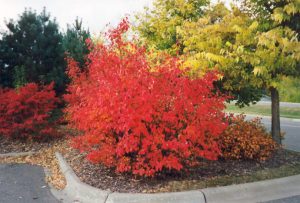
Chokecherries grow wild in most areas of Michigan and are native to the state. They have beautiful white blossoms in late spring or early summer and dark purple fruit in late summer or fall, depending on when they may have gotten a hard frost. The bark is light gray and smooth with no ridges.
Dogwood
Several types of dogwoods grow in the state. They grow relatively tall and have white blossoms in late spring or early summer, after which the leaves emerge. The bark is gray and smooth with tiny ridges.
Black Gum
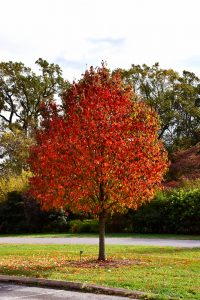
Black gum trees have fragile bark, which is black and very smooth. The branches hang on one side of the trunk, like the leaves on curved stalks. They are deciduous, and their leaves turn a bright orange color in fall before falling off the tree completely.
Eastern White Pine
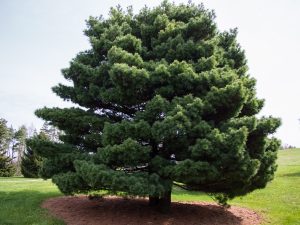
These trees can grow huge, sometimes reaching over 100 feet. Their bark is a light tan color and smooth with no ridges. They are deciduous and have a very soft, sweet smell when their needles begin to fall off in the fall.
Tulip Poplar
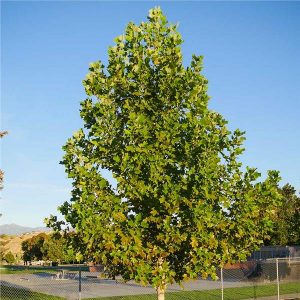
Tulip Poplar trees are deciduous and have a light gray bark with raised, rounded ridges. They are beautiful in the spring when they bloom, usually around the same time their leaves emerge.
Michigan Native Shrubs For Landscaping
Blackhaw Viburnum
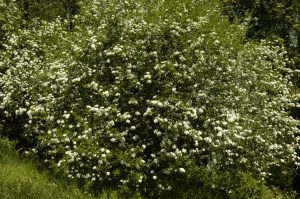
The Blackhaw Viburnum is an herbaceous deciduous shrub that produces bright yellow flowers in spring. It grows to be about 3 feet tall and 6 feet wide and should be planted in full sun or partial shade. The plant spreads by suckers and can be used as a shrub border or as a specimen tree. They are best grown on slightly acidic soil with good drainage. These plants do well in the Midwest but don’t do well in extreme conditions such as heat, cold or wet soil.
Common Ninebark
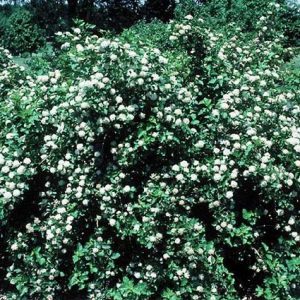
The Common ninebark is a herbaceous deciduous shrub that produces white flowers in late spring. The leaves are dark green and leathery, with a fine texture and an inch wide. They bloom in early summer.
Golden Rhododendron
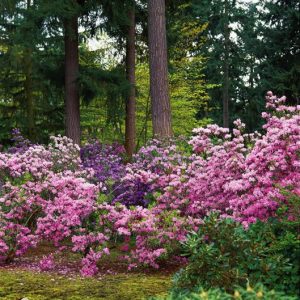
The Golden rhododendron is a large shrub that may grow to 35 feet tall and has fragrant golden blooms in the spring, followed by yellow flowers the following year. They are low-maintenance evergreen shrubs or small trees with long shiny leaves 2 inches in length. Rhododendrons are best planted in areas with well-drained soil and full sun for the best growth.
Gray Dogwood
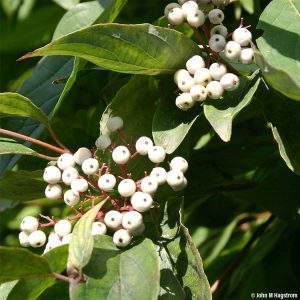
The Gray dogwood is a small deciduous shrub that grows around 6 feet tall and wide, with attractive white or pinkish flowers in spring. They increase and are low maintenance, so they’re commonly used as ornamental hedges or border plants. You can also plant them on your lawn or in flowerbeds when they’re young, then snip the stems off as they mature to keep them from growing back into a bush.
Northern Bayberry
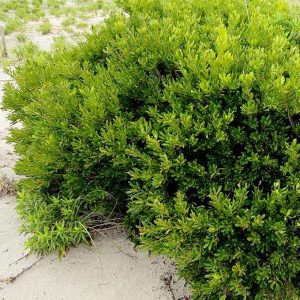
The Northern bayberry is a large shrub that grows around 8 feet tall and wide. It produces fragrant white flowers in mid-spring, followed by glossy dark green oval-shaped leaves about an inch long. The berries are orange and edible for humans but toxic to deer, so it’s a good choice for wildlife habitats. They’re best planted outside during the fall when there is no more risk of frost and grow best in sandy, well-drained soils.
Buttonbush

The Buttonbush is a large deciduous shrub with fragrant white flowers blooming in spring. It grows about 30 feet tall and wide and has long stems with leaves that resemble small green buttons 1 inch in diameter. They grow best in moist soil and partial shade but will tolerate almost any type of soil as long as it’s not too dry or wet.
Bush Honeysuckle
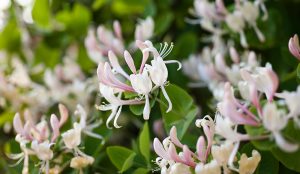
The Bush honeysuckle is a deciduous shrub or vine that grows around 8 feet tall and wide, producing burgundy-colored blooms in mid-spring. They grow well in partial shade to full sun but prefer moist soils. For best growth, they need to be planted in an area with good air circulation.
Common Elderberry
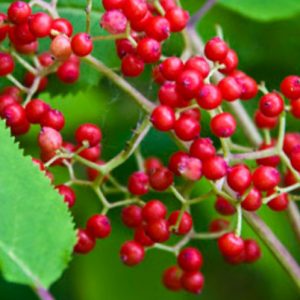
The Common elderberry is a large shrub or small tree with fragrant white flowers in mid-spring, followed by dark purple berries in the fall. It grows around 15 feet tall and wide and grows best in partially shaded locations with full sun.
Smooth Privet
The Smooth privet is a deciduous flowering shrub that grows to be about 5 feet tall and wide, with fragrant white flowers blooming in spring. The stems are smooth and shiny, making this plant a good choice for ornamental use or as a barrier or border plant around your yard.
Winterberry
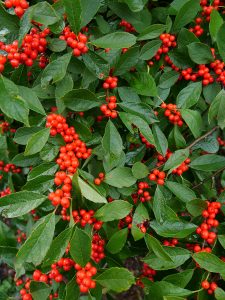
The Winterberry is a large deciduous shrub that grows around 15 feet tall and wide, developing pinkish red fruits in the fall. The fruits can be used to make pies, jams, and jellies, so it’s a good choice for a wildlife food plot. It loves fertile, well-drained soil, but it can survive in poor soils if they’re kept well watered.
Dwarf Huckleberry
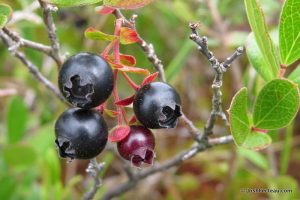
Dwarf Huckleberry is a deciduous shrub with showy orange-red berries in the fall. The stems are smooth, shiny, and thin and can reach heights of 10-12 inches tall and wide at maturity. They are native to eastern North America and prefer moist, well-drained soil.
Common Snowberry
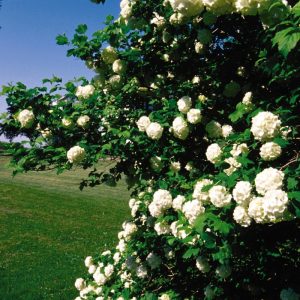
The Common Snowberry is a deciduous shrub with showy pale pink flowers in late summer and can reach heights of 6 feet at maturity. The berries are edible to humans but poisonous to deer, so they’re a good choice for creating wildlife food plots.
Silky Dogwood
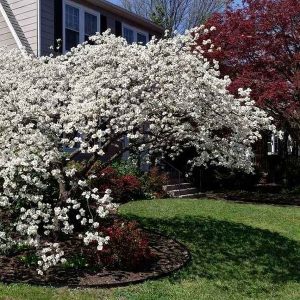
The Silky Dogwood is a large deciduous shrub with attractive white or pinkish flowers in spring. It grows around 15 feet tall and wide and can adapt to many different soil types as long as they’re well drained.
Smooth Sumac

The Smooth sumac is a large deciduous shrub that produces fragrant white flowers in summer and dark red berries in the fall. It grows to be around 10 feet tall and wide and is an excellent choice for wildlife food plots because deer don’t eat the fruit of this plant.
Pagoda Dogwood
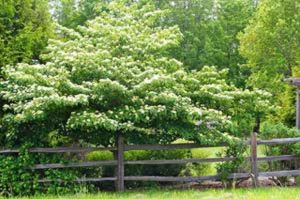
The Island or Pagoda dogwood is a small deciduous shrub with fragrant white flowers in mid-spring. It grows 5 feet tall and wide and produces dark red berries in the fall, a favorite food of birds and small mammals. They are best planted outside during the fall when there is no more risk of frost and grow best in moist, sandy soil.
Kinnikinnick
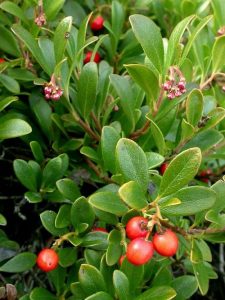
The Kinnikinnick is a small deciduous shrub that grows about 4 feet tall and wide, producing pale yellow flowers in late summer. These plants grow best when there is partial to full shade and survive as long as they receive reasonable water.
Swamp Azalea
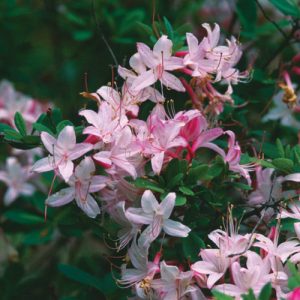
The Swamp azalea is a deciduous shrub that grows around 10 feet tall and wide, with pink or white flowers in spring. They produce shiny black berries in the fall, an important food source for many birds in the winter. The plant prefers moist, well-drained soil, but it will tolerate most soil types as long as they’re not too wet.
Swamp Rose
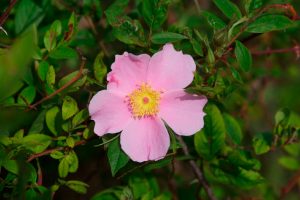
The Swamp rose is a large deciduous shrub or small tree that grows about 20 feet tall and wide. It has fragrant white flowers in summer and dark red fruits in the fall, an important food source for many birds during winter. The plant prefers moist soil with good air circulation, but it will survive almost anywhere as long as it receives plenty of water.
American Hazelnut
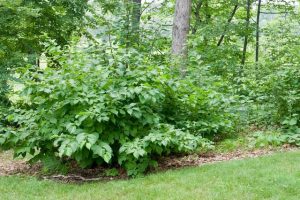
The American hazelnut is a large deciduous shrub with fragrant white flowers in late spring. It grows to be around 20 feet tall and wide and produces dark brown nuts in September, which are edible for humans but poisonous to most animals. They grow best in moist soil but can tolerate dry or wet conditions as long as they’re not overwatered.
Michigan Native Perennials For Landscaping
Anemone
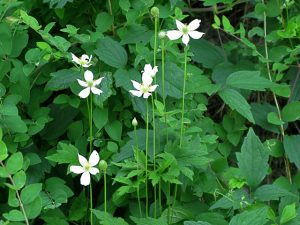
Wood Anemone is a spring wildflower with showy flowers that bloom from March through May. The flowers range from pink to red and can be solitary or in clusters. The large green leaves are divided into three large lobes, and at first glance, they may look similar to an iris, but the leaves are not fragrant. Anemones are low-maintenance perennials native to wet woodlands and will grow 12 inches to 3 feet tall. They do best in partial shade or full sun and moist soil with good drainage.
Bee Balm
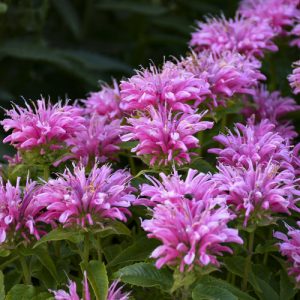
Bee balm is a perennial that blooms from late summer through into fall. The flowers are clusters and have five pale yellow or almost white petals. The leaves are opposite and also divided into three lobes with serrated edges, and they can grow as tall as 1 foot high. Bee balm blooms best in semi-shade areas with moist soil and regular watering but will tolerate dry soil.
Bloodroot
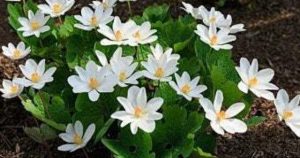
Bloodroot is a perennial with showy scarlet flowers that bloom from July through September. The flowers bloom from beneath the leaves, giving a lovely effect. This plant will grow from 8-12 inches tall, best grown in a container or a bed of pebbles. Bloodroot prefers dry, well-drained soil and will die back entirely if the soil is too wet or too dry.
Blue Violet
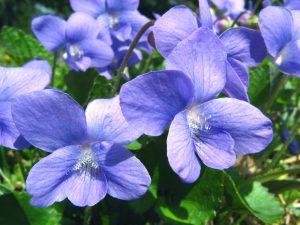
Blue violets are perennial flowers with fragrant blue flowers; they bloom in early spring. The leaves are very light green, triangular, and divided into three segments, the petals are white to bluish-white, and they have a sweetly spicy fragrance. Blue violets are best grown in moist, well-drained soil in full sun or partial shade.
Butterfly Weed
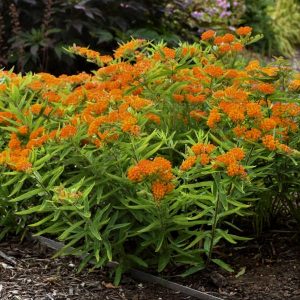
Butterfly weed is an herbaceous perennial with showy yellow flowers blooming from May through June. The yellow coloring can easily distinguish the stamens and petals because the stamens protrude from the flower, giving it an “eye.” Butterfly weed will grow from 3-5 feet tall but is drought tolerant and can be grown in partial shade. It prefers moist, well-drained soil.
Cinquefoil

Cinquefoil is a herbaceous perennial that blooms from late spring through early summer. The pink flowers have five petals and are strongly scented. They can grow 2-4 inches in height and are best grown in moist, well-drained soil.
Coralroot
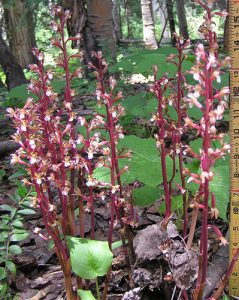
Coralroot or Indian paintbrush is a perennial that grows from a rhizome, with bright yellow flowers growing from its base around the same time as the leaves. It can grow as tall as 3 feet but prefers partial shade or full sun and will tolerate dry soil. They do best when planted in groups to make an attractive border.
Daylily
Daylilies are perennials with fragrant flowers in the late spring through early summer. They have large grass-like leaves with flowers ranging from white to reddish purple to pink; they grow best in partial shade or full sun along with moist soil with good drainage.
Dittany
Dittany is an herbaceous perennial with fragrant pink flowers blooming in late spring through early summer. They grow best in partial shade and moist, well-drained soil.
Elecampane
Elecampane is a perennial with fragrant white flowers that grow in clusters on the ends of branches from June through July. The leaves can reach as tall as 3 feet but prefer partial shade or full sun along with moist or dry soil.
Wild Ginger
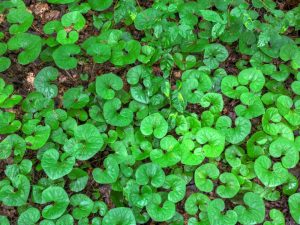
Wild ginger is an herbaceous perennial that grows from a rhizome with fragrant yellow flowers that bloom from May through June. It will grow up to 2 feet tall, but you can plant it in full sun and dry soil if you want to keep it shorter. The stems of this plant are hollow and can be as tall as 12 inches, so it’s best grown in a container or planted on the ground.
Goldenrod
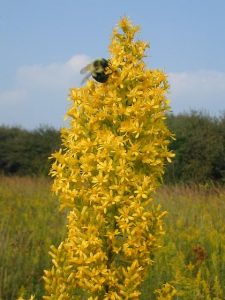
Goldenrod is a perennial herb that can grow up to 3 feet tall. It has fragrant yellow flowers and silvery, woolly leaves. It grows best in partial shade and moist, well-drained soil.
Groundsel
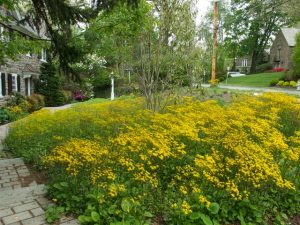
Groundsel is a perennial herb with three-lobed white leaves and yellow or blue flowers that bloom from May through June. The stems of this plant are hollow and can be as tall as 12 inches, so it’s best grown in a container or planted on the ground.
Indian Pipe
Indian pipe is a perennial that blooms in late spring. It grows 1-3 feet tall with bell-shaped tubular flowers. They prefer partial shade or full sun and moist or dry soil.
Lobelia
Lobelia is a perennial wildflower that blooms from mid-summer through early fall. The flowers range in color from light blue to violet, pink, and lavender, with two lips that resemble a fish. They grow best in moist soil and partial shade but will tolerate almost any type of soil as long as it’s not dry.
Milkweed
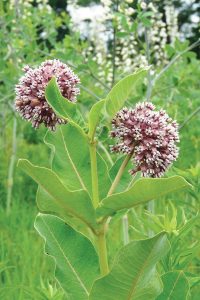
Milkweed is a perennial with showy pink, white or purple flowers blooming from midsummer through fall. The leaves are upright and divided into three lobes. They can grow as tall as 3 feet but prefer partial shade or full sun. Milkweed will tolerate dry soil but should not be allowed to become overly dry.
Monkshood
Monkshood is a perennial that has poisonous blue-purple flowers. This plant should not be ingested. It grows best in moist, well-drained soil.
Oxeye Daisy
Oxeye daisy is a perennial that blooms from mid-summer through early fall. The flowers range in color from light blue to violet, pink, and lavender, with two lips that resemble a fish. They grow best in moist soil and partial shade but will tolerate almost any type of soil as long as it’s not dry.
Partridgeberry
Partridgeberry is a perennial wildflower that blooms from mid-summer through early fall. The flowers range in color from light blue to violet, pink, and lavender, with two lips that resemble a fish. They grow best in moist soil and partial shade but will tolerate almost any type of soil as long as it’s not dry.
Penstemon
Penstemon is an herbaceous perennial with red, pink, or purple flowers that bloom from late spring through early summer. They grow best in partial shade and moist, well-drained soil.
Oswego Tea
Oswego tea is an herbaceous perennial that produces white flowers in the spring. This plant blooms best with adequate moisture once established and grows well in partial shade.

